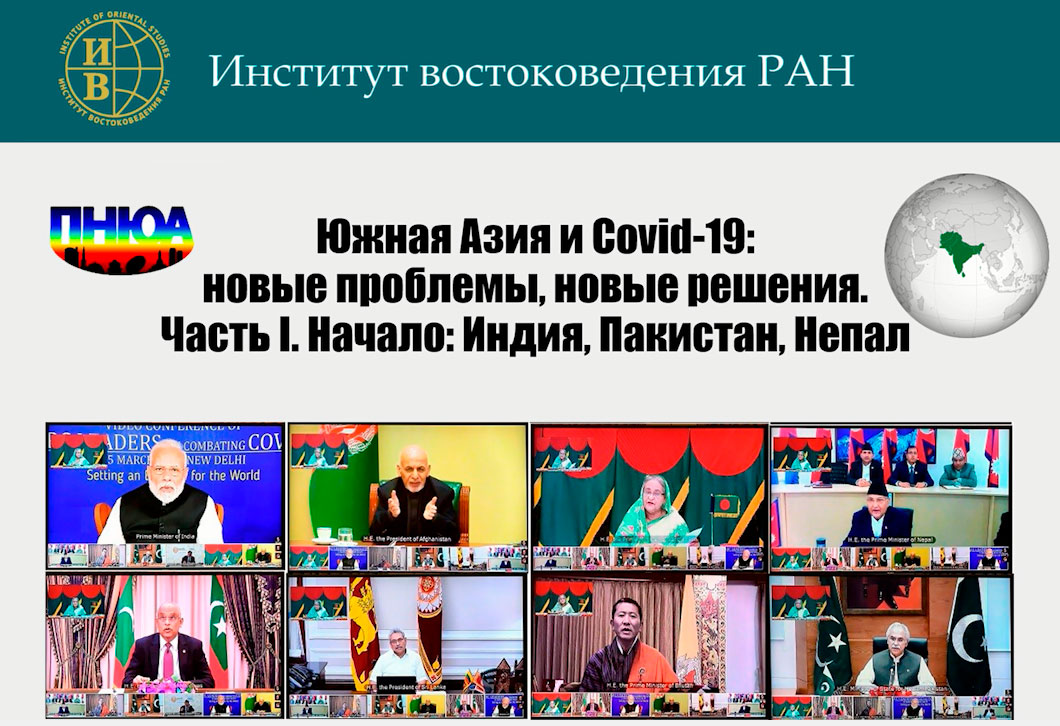News
Tuesday 21 July 2020
Round Table “South Asia and COVID-19. Part 1. India, Pakistan, Nepal" Part2. Report "Hinduism in Conditions of Force Majeure"

The remote round table was organized by the Interdisciplinary Project Group "Under the Sky of South Asia" (USSA) of the Institute of Oriental Studies (the Russian Academy of Sciences).
The interdisciplinary project-group "Under the Sky of South Asia" (USSA) of the Institute of Oriental Studies (https://ivran.ru/pnua) is engaged in a comprehensive study of seven countries: huge India and embracing it Pakistan, Bangladesh, Nepal, Bhutan, Sri Lanka, and Maldives. These states are interlinked by history, culture, politics, and economics. The choice of the topic for the round table was determined by a force majeure situation. Recently the whole world had found itself under the impact of the coronavirus infection. The fight against the virus unified all the countries of the world.
In general, the countries of the region turned out to be very unprepared for the pandemia. The main meme of this day became the phrase “you never know, what the future brings”, because the virus had taken a lot of human lives and people were unready to cure the disease.
The round table was conducted on the 7th of June, 2020. Up to this date 1 million cases of COVID-19 had been registered in the three countries of the region.
The collective performances in the form of different movement rituals are a striking feature of modern Hinduism. These include the vari, an annual collective pilgrimage to the holy city of Pandharpur to Vithoba/Vitthal, the ancestral deity of Maharashtra (a historical region and administrative state in Western India). This event, when the whole region is engaged in a shared sense of belonging, has transformed (as defined Iravati Karve, a sociologist and anthropologist) the Marathi-speaking region into "a country whose people go on pilgrimage." Religious centers often turn into foci of infection due to the mass people gathering who become carriers of the infection.
The colonial government adopted the "Law on Epidemiological Diseases" back in 1897, in the midst of a plague epidemic in the same area. The law enabled the authorities to introduce strict rules managing the population's lives during pandemia. The same law became the basis for the lockdown introduction throughout India in March 2020, i.e. de facto banning the people’s travelling. Therefore the law made it impossible for religious institutions to function.
Irina Glushkova, an observer of the 230-kilometer route from Alandi, the place of veneration for Dnyeshwar, the author of the first commentary on the Bhagavad-gita in Marathi language, to Pandharpur. She is the author of the book "Indian Pilgrimage. Metaphor of Movement and Movement of Metaphor" (Moscow: Nauchniy Mir, 2000). Irina Glushkova told at the round table of the varkari tradition, i.e. those people who accomplish vari. Also she narrated at the meeting how 30 years later she became once again a participant in the virtual pilgrimage.
The book "Indian Pilgrimage. The Metaphor of Movement and Movement of Metaphor" is in the catalog of books of the Institute of Oriental Studies: https://book.ivran.ru/book?id=269